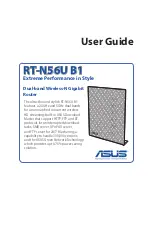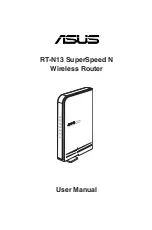
6 - 12 WiNG 5.7.1 Access Point System Reference Guide
MAC Authentication Deployment Considerations
Before defining a MAC authentication configuration on a WLAN, refer to the following deployment guidelines to ensure the
configuration is optimally effective:
• MAC authentication can only be used to identify end-user devices, not the users themselves.
• MAC authentication is somewhat poor as a standalone data protection technique, as MAC addresses can be easily spoofed
by hackers who can provision a MAC address on their device to mimic a trusted device.
6.1.2.3 PSK / None
Configuring WLAN Security Settings
Open-system authentication can be referred to as no authentication, since no actual authentication and user credential
validation takes place. When selecting PSK/None, a client requests (and is granted) authentication with no credential
exchange.
6.1.2.4 Captive Portal
Configuring WLAN Security Settings
A
captive portal
is guest access policy that provides temporary and restrictive access to the wireless network. The primary
means of securing such guest access is the use of a captive portal. For an overview of the captive portal process and
information on how to define a captive portal policy that can be applied to a WLAN, see
Configuring Captive Portal Policies on
To assign a captive portal policy to a WLAN:
1. Select the
Configuration
tab from the Web UI.
2. Select
Wireless.
3. Select
Wireless LANs
to display a high level display of existing WLANs.
4. Select the
Add
button to create an additional WLAN or select an existing WLAN and
Edit
to modify the properties of an
existing WLAN.
5. Select
Security
.
6. Refer to the
Captive Portal
field within the WLAN security screen.
Select the
Captive Portal Enable
option if authenticated guess access is required with the selected WLAN. This feature
is disabled by default.
7. Select the
Captive Portal if Primary Authentication Fails
option to enable the captive portal policy if the primary
authentication is unavailable. This option is only enabled when
Captive Portal Enable
is selected.
8. Select the
Captive Portal Policy
to use with the WLAN from the drop-down menu. If no relevant policies exist, select the
Create
icon to define a new policy to use with this WLAN or the
Edit
icon to update the configuration of an existing captive
portal policy. For more information, see
Configuring Captive Portal Policies on page 9-2
9. Select
OK
when completed to update the captive portal configuration. Select
Reset
to revert the screen back to the last
saved configuration.
NOTE:
Although
None
implies no authentication, this option is also used when
pre-shared keys are used for encryption (thus the /PSK in the description).
Summary of Contents for WiNG 5.7.1
Page 1: ...WiNG 5 7 1 ACCESS POINT SYSTEM REFERENCE GUIDE ...
Page 2: ......
Page 3: ...WING 5 7 1 ACCESS POINT SYSTEM REFERENCE GUIDE MN001977A01 Revision A April 2015 ...
Page 4: ...ii WiNG 5 7 1 Access Point System Reference Guide ...
Page 24: ...1 4 WiNG 5 7 1 Access Point System Reference Guide ...
Page 36: ...2 12 WiNG 5 7 1 Access Point System Reference Guide ...
Page 72: ...3 36 WiNG 5 7 1 Access Point System Reference Guide ...
Page 470: ...5 386 WiNG 5 7 1 Access Point System Reference Guide ...
Page 472: ...6 2 WiNG 5 7 1 Access Point System Reference Guide Figure 6 1 Configuration Wireless menu ...
Page 624: ...7 46 WiNG 5 7 1 Access Point System Reference Guide ...
Page 724: ...9 56 WiNG 5 7 1 Access Point System Reference Guide ...
Page 783: ...12 35 Figure 12 46 Device Summary screen 4 Click File Management ...
Page 816: ...12 68 WiNG 5 7 1 Access Point System Reference Guide ...
Page 1006: ...13 190 WiNG 5 7 1 Access Point System Reference Guide ...
Page 1026: ...14 20 WiNG 5 7 1 Access Point System Reference Guide ...
Page 1028: ...A 2 WiNG 5 7 1 Access Point System Reference Guide ...
Page 1089: ......
Page 1090: ...MN001977A01 Revision A April 2015 ...
















































